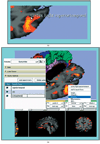A national human neuroimaging collaboratory enabled by the Biomedical Informatics Research Network (BIRN)
- PMID: 18348946
- PMCID: PMC2763494
- DOI: 10.1109/TITB.2008.917893
A national human neuroimaging collaboratory enabled by the Biomedical Informatics Research Network (BIRN)
Abstract
The aggregation of imaging, clinical, and behavioral data from multiple independent institutions and researchers presents both a great opportunity for biomedical research as well as a formidable challenge. Many research groups have well-established data collection and analysis procedures, as well as data and metadata format requirements that are particular to that group. Moreover, the types of data and metadata collected are quite diverse, including image, physiological, and behavioral data, as well as descriptions of experimental design, and preprocessing and analysis methods. Each of these types of data utilizes a variety of software tools for collection, storage, and processing. Furthermore sites are reluctant to release control over the distribution and access to the data and the tools. To address these needs, the Biomedical Informatics Research Network (BIRN) has developed a federated and distributed infrastructure for the storage, retrieval, analysis, and documentation of biomedical imaging data. The infrastructure consists of distributed data collections hosted on dedicated storage and computational resources located at each participating site, a federated data management system and data integration environment, an Extensible Markup Language (XML) schema for data exchange, and analysis pipelines, designed to leverage both the distributed data management environment and the available grid computing resources.
Figures






References
-
- Papadopoulos PM, Katz MJ, Bruno G. NPACI Rocks: Tools and techniques for easily deploying manageable Linux clusters. Proc. IEEE Int. Conf. Cluster Comput. 2001:258–267.
-
- Foster I, Kesselman C. The Grid: Blueprint for a New Computing Infrastructure. San Mateo, CA: Morgan-Kaufman; 1999. Computational Grids. ch. 2.
-
- Foster I, Kesselman C. The globus project: A status report. Proc. IPPS/SPDP’1998 Heterogeneous Comput. Workshop. :4–18.
-
- Thain D, Tannenbaum T, Livny M. Condor and the grid. In: Berman F, Hey A, Fox G, editors. Grid Computing: Making the Global Infrastructure a Reality. New York: Wiley; 2003.
-
- Tannenbaum T, Wright D, Miller K, Livny M. Condor—A distributed job scheduler. In: Sterling T, editor. Beowulf Cluster Computing With Linux. Cambridge, MA: MIT Press; 2002.
MeSH terms
Grants and funding
LinkOut - more resources
Full Text Sources
Other Literature Sources

